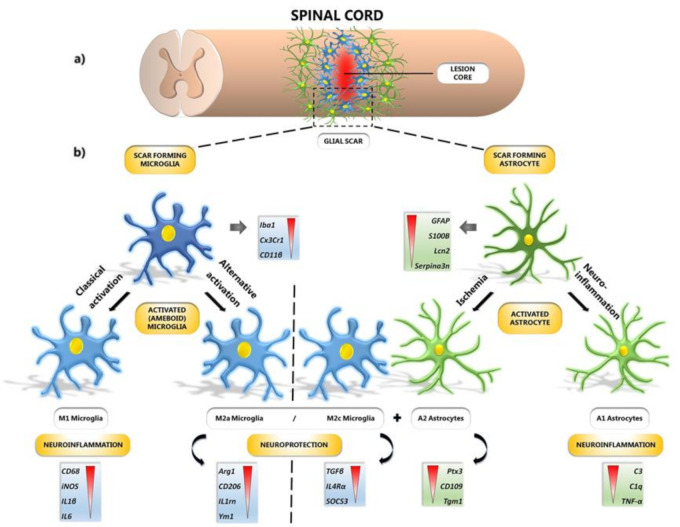Figure 1.
Formation of glial scar after SCI. (a) Spinal cord with illustrated lesion core surrounded by microglia and astrocytes, forming a glial scar. (b) Focusing on specific types of glial cells: microglia and astrocytes with their corresponding genes ranked according to expression level. Resting microglia and astrocytes acquire scar-forming phenotypes through their activation under certain conditions; they differentiate into several subtypes involved either in neuroinflammation (M1, A1) or neuroprotection (M2a, M2c, A2). The M1 phenotype of microglia is acquired by classical activation, whereas M2a and M2c phenotypes are acquired by alternative activation pathways. Astrocytes, which are differentiated into A2 phenotype under ischemic conditions, promote neuronal survival and tissue repair. A1 phenotype is acquired via secretion of neuroinflammatory markers. Iba1—ionized calcium-binding adaptor molecule 1; Cx3Cr1—fractalkine receptor; Cd11β—beta-integrin marker of microglia; GFAP—glial fibrillary acidic protein; S100B—calcium-binding protein B; Lcn2—lipocalin 2; Serpina3n—serine (or cysteine) peptidase inhibitor; CD68—cluster of differentiation 68; iNOS—inducible nitric oxide synthase; IL-1β—interleukin-1β; IL-6—interleukin-6; Arg-1—arginase-1; CD206—mannose receptor and C-type lectin; IL1rn—interleukin 1 receptor antagonist; Ym1—chitinase-like protein-1; TGF-β—transforming growth factor beta; IL4Rα—interleukin 4 receptor alpha; SOCS3—suppressor of cytokine signaling 3; Ptx3—pentraxin 3; CD109—cluster of differentiation 109; Tgm1—transglutaminase 1; C3—complement 3; C1q—complement component 1q; TNF-α—tumor necrosis factor-alpha; SCI—spinal cord injury.

